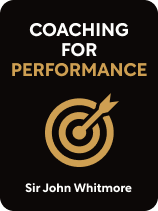

This article is an excerpt from the Shortform book guide to "Coaching for Performance" by Sir John Whitmore. Shortform has the world's best summaries and analyses of books you should be reading.
Like this article? Sign up for a free trial here.
What are some good ways to build trust with employees? How can leaders connect better with their employees?
To build trust with employees, performance consultant Sir John Whitmore suggests that leaders learn coaching skills to empower their employees and make the most of their potential. In Coaching for Performance, he provides coaching strategies for leaders hoping to build trust in the workplace.
Read on to learn how to build trust with employees as a leader, according to Whitmore’s advice.
Build Trust and Connect With Employees
Sir John Whitmore wrote Coaching for Performance to show leaders how to build trust with employees, empower them, and reveal their full potential by adopting a “we’re in it together” mindset. Whitmore is a pioneer of workplace coaching and co-creator of the popular GROW model, a coaching framework for goal setting and performance improvement. The International Coach Federation gave him the President’s Award in 2007 to honor his lifetime of work.
In this article, we’ll specifically look at Whitmore’s advice for building trust with employees as a leader, based on his book Coaching for Performance.
Listen Actively
Whitmore says you have to build trust and connect with your employees so they’ll open up and engage fully in the coaching process, which will help you maximize their potential. To build trust with employees, listen actively to show that you care and be aware of your own thoughts and feelings so they don’t interfere with your work, says Whitmore.
(Shortform note: In Captivate, Vanessa Van Edwards suggests two different ways to establish trust upon first meeting. First, hold eye contact in 60 to 70 percent of your interactions to show interest. Then, keep your hands visible and gesture with them to demonstrate that you’re not hiding anything.)
When you listen carefully to your employee, you show that you care about them, making it easier to build trust with them and more likely that they’ll share information that will help you maximize their potential. Whitmore outlines several strategies to be an effective listener, including these three:
1. Pay attention to your employee’s tone of voice and choice of words. This gives you an idea of what they feel strongly about and areas to explore more deeply. For example, if they say, “I hate when my coworker talks over me at meetings!” in an irritated tone, probe deeper to see if they feel their ideas are regularly overlooked and want others to acknowledge them.
(Shortform note: Words and tone can take on a different life in email and text—communication forms where tone is difficult to interpret. In one study on this subject, participants only successfully deciphered sarcasm or seriousness in emails 56% of the time—but when they heard the same content on voicemail, they successfully interpreted them 73% of the time.)
2. Observe your employee’s emotions and body language. When you pay attention to your employee’s physical cues, you gain deeper insight into how they truly feel. For example, if you ask your employee how they’re doing and they say “Great,” but are slumped in their chair, arms crossed over their chest, they’re probably not great.
(Shortform note: In Captivate, Van Edwards suggests another type of body language to keep an eye out for to assess people’s honesty: facial microexpressions. These momentary, almost imperceptible facial gestures communicate anger, contempt, happiness, fear, surprise, disgust, and sadness. Look for them to see if people’s words match their true emotions.)
3. Reflect back on what your employee says. When you reflect back your employee’s words and thoughts, you build trust with them by showing that you’re paying attention to and are working to understand them. There are multiple ways to reflect back what your employee says, including these three:
- Mirroring. You repeat back your employee’s exact words
- Summarizing. You offer a synopsis of what your employee said, keeping the original meaning intact
- Paraphrasing. You translate what your employee said into your own words, preserving their meaning
(Shortform note: In Coach the Person, Not the Problem, Marcia Reynolds says these strategies are part of the “reflective inquiry process,” which helps illuminate your employee’s deeply held beliefs. When you repeat back what your employee has said—either in their exact words or another framing—you interrupt their automatic thought process and give them a chance to reflect more deeply. This deeper level of self-inquiry expands your employee’s sense of self and options and empowers them to make lasting change.)
Be Aware of Your Thoughts and Feelings
To build trust with your employees, Whitmore also says that you should monitor your thoughts and emotions before and during sessions to connect with your employee in an unbiased manner. Failure to let go of negative ideas and judgments about your employee can damage your perception of them as a partner.
(Shortform note: Reynolds says one way to let go of negative thoughts and emotions is to consciously stay “in the moment.” Before each session, choose one or two emotions that will allow you to be present and support your employee. For example, if your employee is anxious and negative, choose to be calm and positive, then root yourself in these emotions in your session.)
Exercise: Build Trust and Connect
Whitmore says you have to build trust with your employee so they’ll engage in the coaching process, which will improve results. To do this, he suggests that you listen actively to show that you care, and be aware of your thoughts and feelings so they don’t negatively impact your work.
- Whitmore recommends that to listen actively to your employee, pay attention to their tone of voice, word choice, body language, and emotions. Think about a recent situation in which you were coaching someone or serving in a coaching-type role. Describe the listening techniques you employed and what you feel did and didn’t work.
- Let’s say you’re going to meet with this employee again. What two of Whitmore’s active listening strategies could you use to connect even more deeply?
- Whitmore says it’s critical to monitor your thoughts and emotions before and during sessions so you don’t harbor judgments that can negatively impact your partnership. Reflect on a time when you judged a employee or someone else you were talking to. What was the judgment you made of them, and how did it impact your conversation?
- Now think about meeting with that same person again. What can you do to address judgmental thoughts and emotions so they don’t impact your conversation and relationship?

———End of Preview———
Like what you just read? Read the rest of the world's best book summary and analysis of Sir John Whitmore's "Coaching for Performance" at Shortform.
Here's what you'll find in our full Coaching for Performance summary:
- A guide on the ins and outs of performance coaching
- Strategies to maximize employees’ potential and performance
- How to measure organizational culture and the impact of your work






